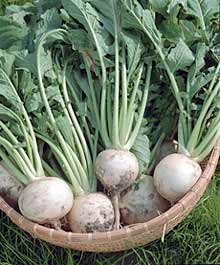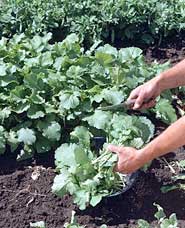
Turnips and their kin, the rutabagas, are no-frills vegetables. Traditionally, they've offered plenty of utility, if not much flair. However, promising new varieties are available, and adventurous chefs are giving these old standbys a fresh look.
Here we offer varieties and growing techniques to ensure delicately flavored roots (unlike the tough, cabbage- flavored ones you may remember from childhood). And, if you live in cold-winter regions, don't overlook rutabagas, which are among the hardiest of all vegetables. You can harvest them (when nothing else is growing) well into the fall and winter if you follow the techniques here.
 Family Relations
Family Relations
Scientists believe that the turnip (Brassica rapa), a white- or yellow-fleshed and often purple-shouldered root, is of European or western Asian origin. Humans have been growing and consuming turnips for thousands of years. The rutabaga (B. napus), sometimes called a Swede turnip (or just plain "Swede"), was developed in Europe in the Middle Ages and is believed to be a cross between the turnip and some form of cabbage. Usually solid yellow or sometimes white fleshed, it found its way into American gardens in the early 1800s.
Turnips and rutabagas have similar growth requirements. Both flourish in cool weather when planted in fertile, loose soil. Turnips grow fast, reaching full 1 1/2-inch size 35 to 50 days after planting. Rutabagas, which are larger, starchier, and sweeter than turnips, take about a month longer. Both tolerate frosts, but rutabagas are much hardier. They also store well, up to 6 months compared to 4 months for turnips.
Turnips grow best in soil with a pH of 5.5 to 6.8, and rutabagas prefer a slightly sweeter soil pH in the 6.0 to 7.2 range. Dig and loosen the soil to a depth of 10 to 12 inches; loose soil is vital to producing fat, tender roots. Too much nitrogen, however, will force top growth and diminish root quality. Plant in rows or narrow bands, spacing seeds about 1 inch apart; cover with 1/4 to 1/2 inch of soil. After planting, water gently with a fine spray to moisten the soil.
Turnips and rutabagas are fairly trouble-free, with root maggots and flea beetles the most probable pests. Both can be excluded by covering the seeded area with a floating row cover immediately after planting; leave the cover on while plants grow. Rotenone also controls flea beetles.
How to Grow and Enjoy Turnips
Turnips are popular in culinary circles, and it's not because the ancient plant has radically changed. The new varieties have improved flavor, but mostly, gardeners are just taking a fresh approach to growing and harvesting them. Instead of letting roots reach baseball size, emphasis now is on growing quick-maturing varieties and harvesting roots when they are young and sweetest. Of course, turnip greens remain popular too, especially in the South where they are commonly grown for winter harvest.
Time plantings so roots develop in cool weather; 60° F to 65° F is optimum. In cold-winter climates, sow seeds in early spring for a late-spring or early-summer crop, and again in late summer for an autumn crop. Plan the last planting so roots mature about the time of your first frost. Gardeners in mild-winter climates should sow seeds in early spring and again in autumn.
Turnip roots suffer when forced to compete with each other, so early thinning is important. When plants develop their first set of true leaves, thin them to 2 to 3 inches apart. But don't toss those nutritious thinnings-they're delicious!
Provide an abundant, even supply of water so growth is rapid and even, and the result is sweet, crunchy roots. Cultivate to eliminate weeds that would otherwise compete for space and nutrients.
Harvest greens when they're young and tender. Pick outer leaves an inch or so above the crown; leaves grow back quickly. To store greens, refrigerate them wrapped in damp paper towels; place in a plastic bag. Keep in mind, though, that picking too many leaves will slow growth of the root.
Turnips taste best when about 1 1/2 inches across, but they are still good up to 2 1/2 inches across. The strong flavor often associated with turnips results when roots get too large. Cut off the greens about 1/2 inch from the crown, then refrigerate the roots in a partially opened plastic bag.
Although plants take light frost, turnips are not dependable for winter storage in the ground. Rutabagas are a better choice for keeping through the winter.
Serving ideas. Both turnips and rutabagas have a place in the lighter fare that's becoming popular today. Enjoy them shredded fresh in salads, or lightly steamed. Serve turnips raw with dips, braised in stock, or sliced and baked. Baby ones, unpeeled and with tops still attached, are attractive with a main course. Traditional menus combine both turnips and rutabagas with lamb (roast or stew), duck, and sausages. Steam or boil first, then grill. The more flavorful rutabagas are essential in winter soups, and they can be purchased with potatoes or carrots, or sliced and baked.
Turnip varieties. According to Robert Johnston, founder of Johnny's Selected Seeds in Albion, Maine, the new variety 'Hakurei' (38 days) sets a new standard for flavor-sweet, fruity, and delicate. The roots are smooth, white, and slightly flattened. In contrast to most turnips, 'Hakurei' has smooth, hairless tops, which makes the young greens appealing even in salads. Other fast-maturing varieties-ideal for spring planting and harvesting before the weather warms-include 'De Milan' (35 days), 'Market Express' (30 days), 'Presto' (30 days), 'Tokyo Cross' (35 days), and 'White Lady' (35 days).
For those who prefer larger turnips, old standbys include 'Purple Top White Globe' (55 days) and 'Amber Globe', also called 'Yellow Globe', (63 days). The roots will reach 6 inches in diameter, but they taste best when harvested smaller.
The tops of all turnips are edible, but some varieties are grown exclusively for the greens. Among them are 'Seven Top' (also called 'Southern Prize' or 'Foliage Turnip') and 'All Top'.
How to Grow Rutabagas
Rutabagas flourish and taste best when grown in northern or central regions and planted in late spring or summer so roots mature in cool autumn weather. Rutabagas touched by a few good frosts taste the sweetest.
Sow seeds directly in the garden about 12 weeks before the first expected frost. In mild-winter regions such as southern California, plant seeds in the fall for a winter harvest.
Once the plants develop their first true leaves, thin them to about 6 inches apart. When the tops are 6 inches or so tall, apply a 4-inch layer of mulch, such as straw, to help keep the soil cool and evenly moist. Water as needed.
Rutabaga greens are edible but turn coarse with age. Plan to use only the tender thinnings.
Harvest rutabaga roots when they reach 3 to 5 inches in diameter. Although their flavor improves with frost, once temperatures regularly drop below 20° F, either pull them up or cover them with an 18-inch layer of organic mulch to prevent the ground from freezing. Then, harvest as needed through winter.
Rutabagas will keep for up to 6 months if stored near freezing with 90 to 95 percent humidity. Before storing, cut off the foliage and wash the roots. Store them in a plastic bucket with the lid cocked, or in the refrigerator in a partially open plastic bag.
In boron-deficient soil, the core of the root turns brown. If this is a problem in your area, a good compost is usually a sufficient corrective. If that doesn't help, consult your cooperative extension office.
Varieties
A new variety, 'Joan' (95 days), tastes sweeter and milder than all other yellow-fleshed rutabagas. Among standard yellow-fleshed kinds are 'American Purple Top Yellow' (85-90 days), 'Laurentian' (90 days), and 'Marian'. 'Gilfeather', an heirloom sometimes listed as a turnip in seed catalogs, is usually considered a rutabaga for its large roots and appearance of leaves. It has a white root with green shoulders, and its white flesh is sweet and mild.
Formerly a senior editor for Today's Homeowner magazine, Lynn Ocone grows turnips, rutabagas, and much more in her Burlington, Vermont, garden.
Photography by Didier Delmas/National Gardening Association.
 Victory Seed Company has all the seeds you want for your best garden in 2024.
Victory Seed Company has all the seeds you want for your best garden in 2024.
For 25 years, the family-owned Victory Seed Company has provided the highest quality vegetable, herb and flower seeds to families across the country. We are passionate about providing you the best seeds available that give excellent germination, robust plants, and the harvest you want. With a catalog of over a thousand varieties, we have everything, and our prices are the kinds that we'd want to pay. We have hundreds of yesterday's heirloom vegetables, as well as today's award winning hybrid selections. Get to know us by visiting our website and browsing through our online vegetable seed catalog.